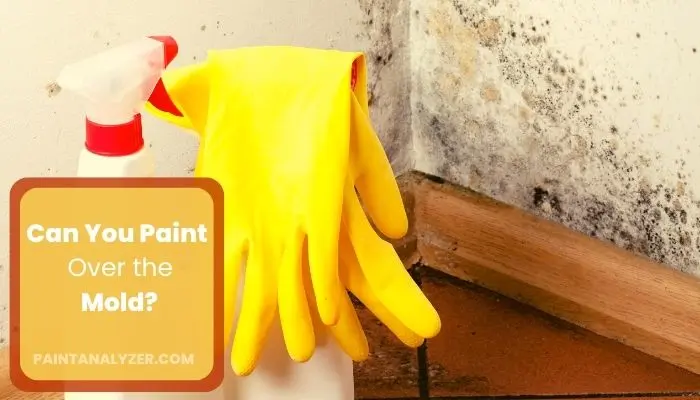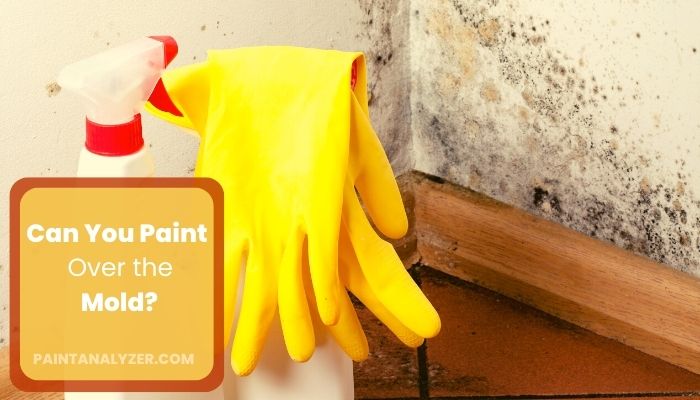Mold is a fungus that can grow indoors or outdoors and thrives in damp, warm, and humid environments. Mold can cause serious health problems, so it’s important to remove it as soon as you see it. But what if you need to paint over mold?
Mold is a serious problem in any home, and it can be tempting to try to simply paint over it and hope the problem goes away. However, this is not an effective solution and can actually make the problem worse. Mold needs to be removed completely before painting. Otherwise, the mold will continue to grow and could cause health problems for you and your family.

Painting over Mold- Is it feasible?
Mold can be a difficult problem to deal with, both aesthetically and health-wise. And it can be especially difficult to deal with in a rental property. If you’re thinking about painting over mold, it’s important to understand the risks involved.
Mold causes serious health problems, so it’s important to take care of it right away. If you’re considering painting over mold, make sure you understand the risks involved.
It’s important to remove mold carefully and safely to avoid making these health problems worse. If you’re considering painting over mold, it’s important to understand a few things first.
What is Mold?
Mold is a type of fungi that thrives in damp, humid environments. It can cause serious health problems, including respiratory problems and allergic reactions. It’s also unsightly and can discolor paint and other surfaces.
That being said, painting over mold is often not the best solution. It’s important to address the underlying problem that’s causing mold growth in the first place. Otherwise, the mold will simply come back.
Mold Resistant Paint
If you do decide to paint over mold, be sure to use mold-resistant paint. These paints contain special ingredients that help to prevent mold growth. They’re usually a bit more expensive than regular paint, but they’re worth it for the added protection.
Will Painting Over Mold Kill It?
You’re probably wondering if painting over it will kill the mold and prevent it from coming back. Unfortunately, painting over mold will not kill the mold or prevent it from coming back. In fact, painting over mold can actually make the problem worse by trapping moisture underneath the paint and creating a perfect environment for mold to grow. The best thing to do is to remove it completely from the wall and clean it properly before painting.
How Can You Remove Mold before Painting?
Mold is a type of fungi that thrives in damp, dark environments. If you’re planning to paint a room in your home that has mold, it’s important to remove the mold first. Otherwise, the mold will continue to grow and could potentially cause health problems.
Mold Remover
The best and easiest option is to use a commercial mold removal product. These products are designed to kill mold and can be found at most hardware stores.
Clean Using Bleach
You can clean the area thoroughly with a mixture of water and bleach. This will kill any mold spores that are present and make it easier to remove any remaining mold. Mix one part bleach with three parts water. This solution can be sprayed on the moldy surface and then scrubbed away.
Take Professional Help
If the mold problem is extensive, you may need to call in a professional. They will be able to assess the situation and recommend the best course of action. In some cases, they may even be able to remove the mold without damaging the paint.
Prevent it from returning
This includes painting the room with mold-resistant paint and making sure that the room is well-ventilated. Taking these precautions will help keep your home mold-free and safe for everyone.
Apply Primer
Once the area is clean, you’ll need to apply a primer specifically designed for use on mold-prone surfaces. This will help to prevent the mold from coming back by creating a barrier between the paint and the surface. Also, be sure to choose a paint that has good mildew resistance in order to further discourage the growth of mold.
Can you apply Paint Over mold?
Are there any paints that kill mold?
Mold is a fungus that can grow on surfaces in your home and can be difficult to remove. Paint is one way that you can use to prevent it from coming back. If you’re looking for paint that will kill mold, you’re out of luck. There is no such thing as paint that can completely eliminate mold spores.
There are a few different types of paint that are effective in preventing mold, and you can choose the one that best suits your needs.
Latex Paint
Latex paint is a water-based paint that is effective in killing mold. It is also mildew resistant, so it can help to prevent mold from growing in the future. You can use latex paint on most surfaces in your home, and it is available in a variety of colors.
Oil Based Paint
Oil-based paint is another option that can be effective in killing mold. It is also more durable than latex paint, so it can last longer on surfaces prone to mold growth. However, oil-based paint is not as easy to clean up as latex paint and is more challenging to work with.
Antimicrobial Paint
Some paints contain antimicrobial agents that can inhibit the growth of mold and mildew. These paints are typically used in high-moisture areas like bathrooms and kitchens or in commercial settings where mold and mildew are more likely to grow. They’re also more expensive than regular paint, so if you want to save some money, you might want to skip the antimicrobial paint.
Can You Paint Over the Mold in the Bathroom?
Mold is a type of fungi that can grow in many different environments, both indoors and outdoors. While mold is often associated with damp, humid conditions, it can also grow in dry areas. Mold thrives on organic matter, such as paper or dust, and can be found in a variety of colors, including black, white, green, and brown.
If you have mold in your bathroom, you may be wondering if you can simply paint over it.
The answer is generally no – while painting over mold may temporarily cover up the problem, it will not solve the underlying issue and the mold will eventually come back. In addition, painting over mold can actually make the problem worse by trapping moisture underneath the paint surface which provides an ideal environment for mold growth.
If the mold is inactive (meaning it’s not currently growing), painting over it with a high-quality primer and paint may help to prevent future growth.
However, keep in mind that even inactive mold can become active again if conditions are right, so regular cleaning and inspection of painted surfaces is still important.

Credit: getbioclean.com
If you have mold growing in your bathroom (or any other area of your home), the best course of action is to have it professionally removed by a qualified remediation company.
This will ensure that all traces of the mold are eliminated so that it doesn’t come back and cause further issues down the road.
Can The Same Paint Used for Rubber be Used to Paint Over Mold?
Yes, the same paint designed for painting rubber surfaces can be used to paint over mold. However, it’s important to properly clean and treat the mold before applying the paint to ensure a smooth and long-lasting finish. This will help to prevent mold growth from reoccurring underneath the new paint layer.
Conclusion
Mold can be a difficult problem to remediate, as it can be difficult to remove completely and can cause health problems. Paint is not an effective solution for mold, as it does not kill mold spores. Instead, it is best to use a mold-killing solution that can be applied directly to the moldy surface.
Mold is stubborn and doesn’t always respond to common household chemicals and treatments. Mold in walls, basements, and attics can grow for years without a visible trace. Even if you can paint over mold, the paint will not completely kill the growth. Consider professional mold removal.

